A complete guide to gurnard fishing looking at the main gurnard species, tub gurnard, grey gurnard and red gurnard with an overview of the streaked, long-finned and piper gurnard.
Gurnards are too often classed as a by-catch by some sea anglers, tending to turn up when fishing for other bottom species. This though, is a blinkered view as gurnards are one of the best looking fish, you’re likely to catch, and in the case of the tub gurnard they can reach a good size, too.
With so many sea anglers now having both annual and life-time species list, gurnards are becoming a popular specific target and it’s worth exploring the various tactics available to us that can produce both higher numbers of gurnards, but also target those bigger specimen sized fish.
There are six gurnards in British and Irish waters. Three are common, one uncommon, and two very rarely caught on rod and line.
We’ll ID all six, but will concentrate on the tub, grey and red which are targetable, whereas the other three, the streaked gurnard, long-finned gurnard and piper are rarely caught on rod and line and can be classed as “lucky” fish if you do catch one.
Tub Gurnard
The tub gurnard has a pointed snout with the front edge carrying two small lobes featuring small spines on the leading edge. The lateral line has small scales and the body scales are small. The main at a glance means of identifying this fish is to check the pectoral fin which reaches well past the vent and well beyond the second dorsal and anal fins forward edge.
Its colouration is also distinctive with the pectoral fins being a bright blue with green or dark spots and the fin edges sometimes tinted in red. The back mixes from bright red or pink shading to orange and then a silver white belly, though this can also be a flushed pink on fish living in deeper water.
The tub is the biggest of our gurnards reaching a plausible weight of around 12lbs. Fish in the 3lbs to 5lbs range are not uncommon if specifically targeted in UK and Irish waters. A fish weighing 4lbs 8ozs would currently be classed as a specimen sized fish
Little known is that tub gurnards are a small shoal fish forming groups of up to 20 fish. However, larger specimens tend to be solitary, or in two’s and three’s indicating these may be the last survivors of the original shoal.
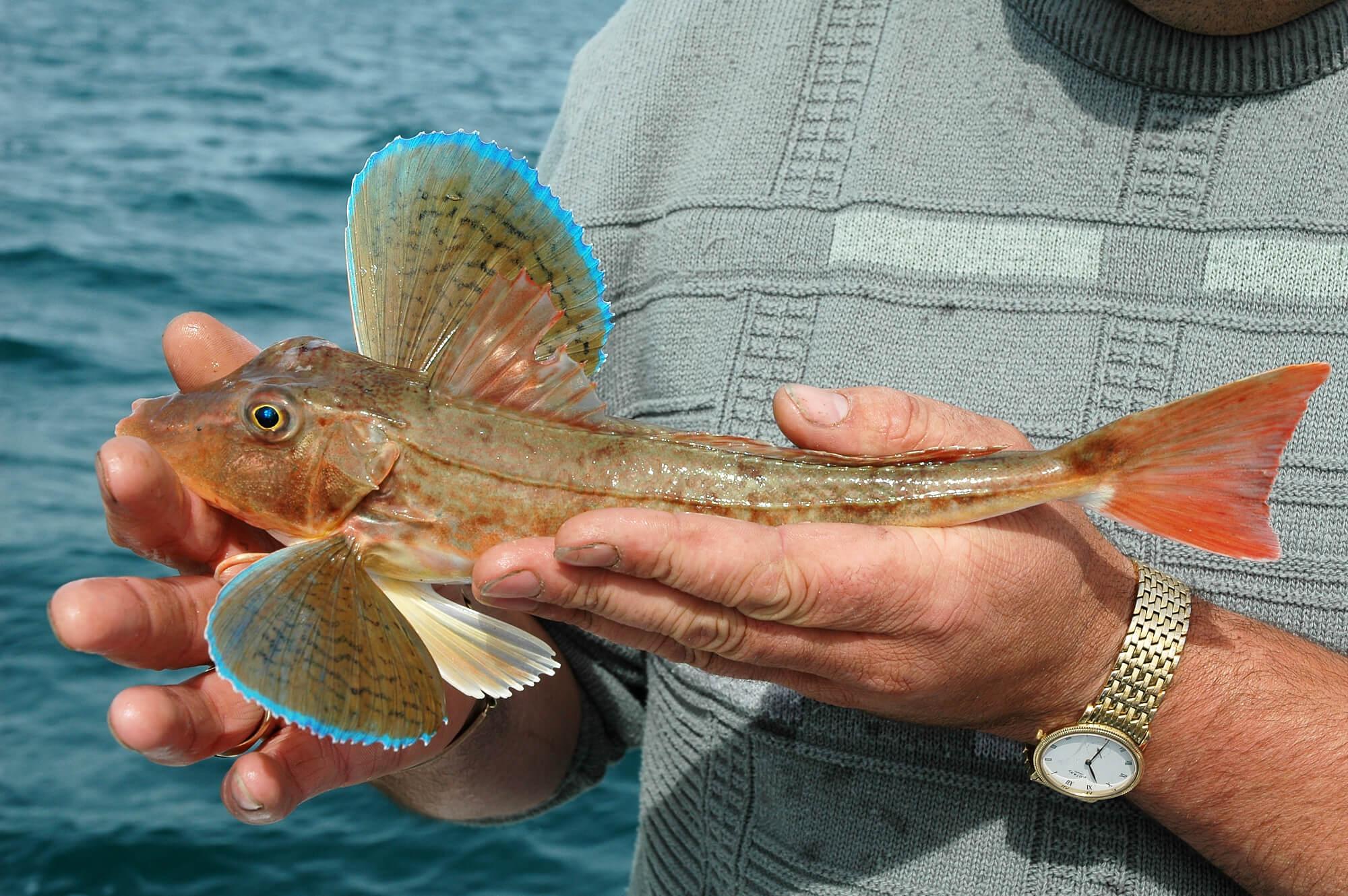
Grey Gurnard
The grey gurnard is a more slender bodied fish with a sharply pointed snout. The angle of the head is straight, unlike the other gurnards which show a distinct dishing in the angle of the front of the head. The pectoral fins do not reach the vent, so use this as a quick form of identification. The lateral line also has sharp and bony scutes that catch the skin when rubbed.
The back and flanks of this fish are a dull grey sometimes with a brown or beige tinge and littered with tiny white or creamy spots. Also look for a dark blotch or spot positioned on the top middle of the first dorsal fin.
It’s rare for a grey gurnard to reach over 3lbs in weight, but a 1.5lb fish can be classed a specimen sized.
Although not classed as a shoaling fish, they are often found in numbers on specific areas of ground best suited to them, but few and far between relatively close by where a ground feature change is evident.
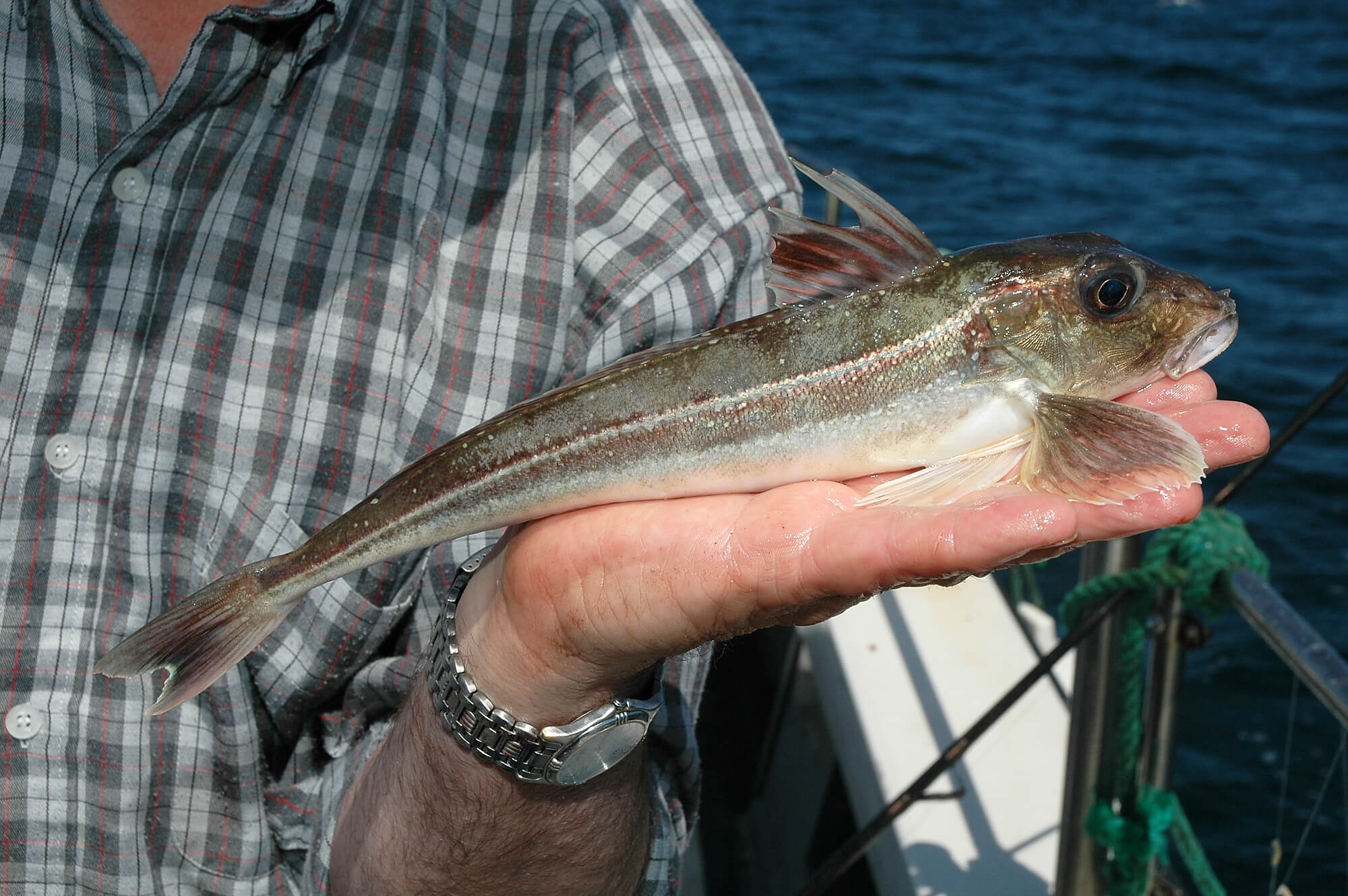
Red Gurnard
This gurnard has a deeper set body shape with more obvious body scales. The lateral line has no sharp spines but is defined by a line of larger scales running right to the tail lobe. When the pectoral fin is laid flat along the body, its tip only just reaches beyond the start line of the anal fin and only just reaches the vent.
The colouration of this gurnard is the giveaway as the name suggests, it being bright red overall with reddy orange sides and a flushed pinky white belly. The ventral fins are pale but with dark at the edges.
The red is one of the smallest gurnards reaching a size of about 3lbs, though bigger fish have been recorded. Your specimen target weight is 2lbs.
It is the least caught of the more common gurnards found in our waters as its habitat is more specifically defined but can be common locally.
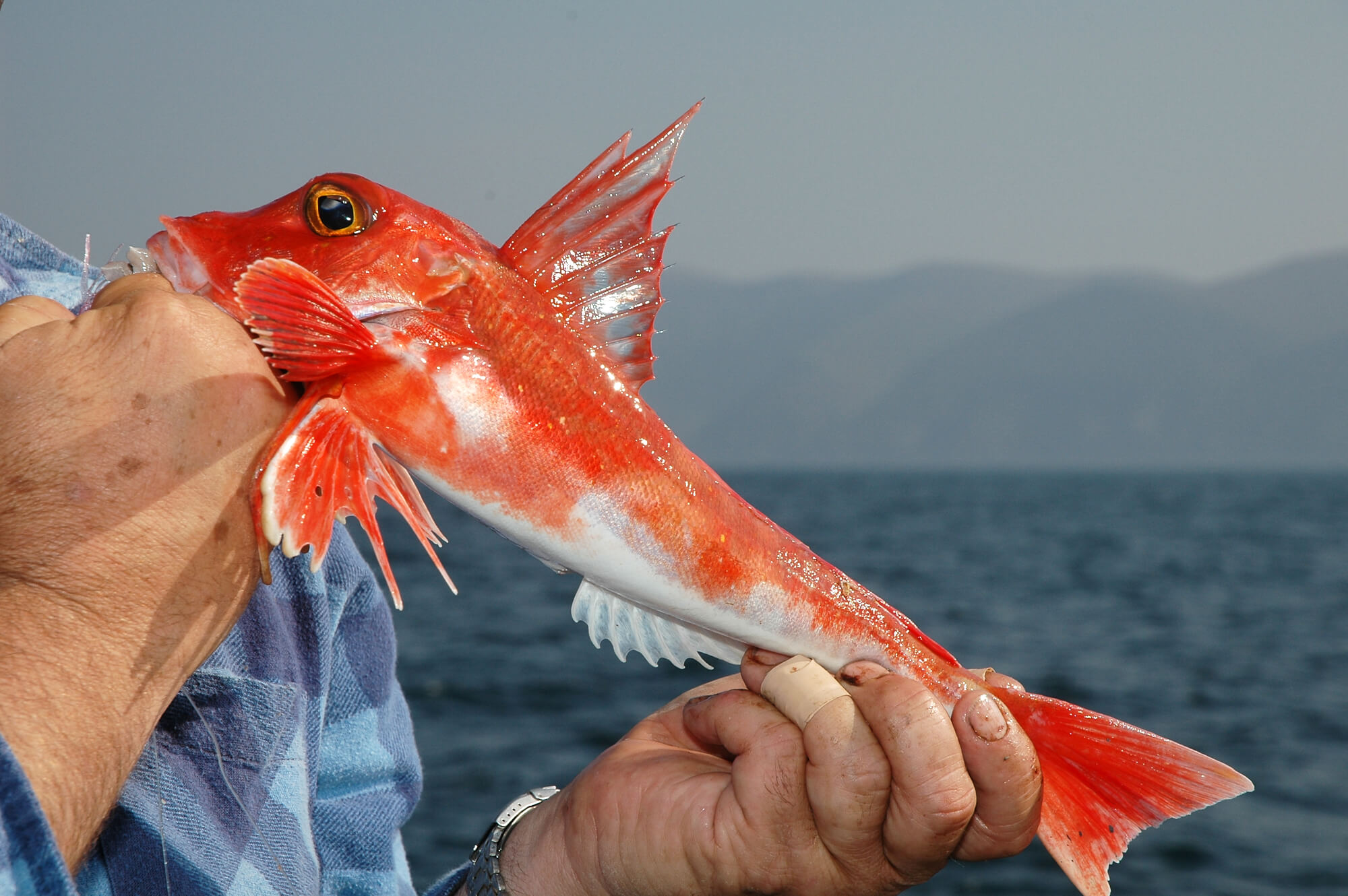
Streaked Gurnard
This is a noticeably much heavier bodied gurnard with a more blunt angle to the head. The lateral line scales have small skin catching points, with the body sporting obvious ridges of skin originating from the lateral line.
The colouration is a dull red to reddish brown back, sometimes with darker patches evident fading into a white belly. The pectoral fins may cause confusion with the tub gurnard being greyish with a red tinge to the edges but with rows of bright blue spots.
It rarely reaches 2lbs in weight and being a deeper water gurnard, it is an uncommon catch.
Long Finned Gurnard
A relatively slender bodied gurnard with a more convex or rounded head than the others. It has a single small spine on each side of the mid-line at the point of the snout. The ID feature for this fish is the long second spine on the first dorsal fin which is visually elongated and twice as long as the other spines, plus it’s thicker at the base. The lateral line is also defined by large flexible scales.
The back is reddish brown and the belly shades to pinkish on the underside. Also look for the lateral line which is pearl-pink in colour and obvious.
Piper Gurnard
The snout is formed into two flattened plates, one each side, with distinct forward pointing teeth, which are the quick means of identification. Just above the pectoral fin also note a large pointed spine, with the other head spines also well developed. The lateral line is smooth, but the body is covered by fine but rough-edged scales. The dorsal fin has sharp spines, but the lateral line is smooth to the touch.
Colour wise this fish can be confused with the red gurnard as the piper is a bright red overall colour fading to a lighter red flush on the forward belly, but pinkish silver around the abdomen.
Tub gurnards are found throughout the Mediterranean, North Africa, up the Spanish, Portuguese and French coast, all around the UK and Ireland, and up as far as the middle of Norway. They are most common on the Atlantic facing coasts and less common, almost non-existent in the northern half of the North Sea.
The very best area for big tub gurnards is either off the southern tip of Cornwall and the Scilly Islands, but especially off the Kerry, Galway, Mayo and Donegal coast in the west of Ireland.
This species has a much wider range than its cousin the tub, being found throughout the Mediterranean and Black Sea, right up the west coast of Europe to middle Norway, and it’s also found off the southern coast of Iceland with localised pods of fish situated between The Faroes and Iceland in the open ocean, this recorded by commercial fishing catches.
It is found throughout the UK, but again is more prominent on the west facing coasts, and throughout Ireland, again the west seeing the biggest numbers and the bigger fish generally.
Although found in the Mediterranean they are less common in the east of this region. Also, though present off the European west coast, they are rarely seen north of the Dutch coast and are pretty much absent from the middle and north of the North Sea.
Their numbers around the UK are concentrated from the English Channel, right up the west coast and throughout the Irish Sea, up as far as the western mouth of the Pentland Firth. They are not present off the northeast coasts of England or Scotland.
They are caught all around Ireland, but the bigger fish and better numbers are on the Atlantic coast with the more northern counties of Mayo and Donegal giving the very best chance of a specimen fish.
Although catches indicate they are present throughout the Mediterranean and the upper tip of North Africa, also the western facing European coast as far as Holland, they are very rare in the southern sector of the English Channel and less so along the west coast, but have been caught in the Irish Sea and off the west of Ireland as far up as Donegal.
It’s usually after a mild winter and a warm spring that these fish show in late summer in our waters with warmer than usual sea temperatures being the main contributor.
This gurnard is restricted to the western side of the Mediterranean, partially down the North African coast, and up the European coast as far as the Brest Peninsula. This is a very rare catch in UK waters and the only real chance is when fishing off the Devon and Cornish coast.
Although found halfway down the west Africa coast, its densest population is in the northern sector of the Mediterranean and up the west European coast as far as the Brest Peninsula. This is a deep water gurnard, so is only found towards the continental shelf and unlikely to be caught by rod and line anglers. There may be a chance off the south west and west coast of Ireland from ports such as Union Hall, Castletownbere, or Cahersiveen, maybe off the Galway Coast but this would be a very long shot.
Juveniles less than a pound in weight can be found close to shore in just a few metres of water up to about 60 feet, but adult tubs are found in water down to about 500 feet or 165-metres but are commonest in depths between 80 feet and 250 feet.
Inshore they favour sandy ground, or sometimes muddy bottoms. The adult fish in deeper water are found on sandy bottoms but tend to be relatively close to rougher ground such as reefs. The biggest fish prefer the sandy patches right in amongst the rough ground using the rough to break the tidal flow over them and provide ambush points to target prey from.
The grey gurnard, mainly the very small juveniles a few inches long, also frequent the shallow waters occasionally, and they especially seem to favour calmer areas such as marinas and harbours feeding over clean sand and mud. The bigger fish though, in contrast, prefer deeper water and are not commonly found in water less than 75 feet and tend to be concentrated in better numbers in water in excess of 100 feet to 250 feet deep. They are also taken though, in depths exceeding 500 feet.
They are found over sand offshore, but will also frequent areas of shell, stone and even live right in amongst the rough ground reef feature.
This gurnard can deceive, and smaller fish can be taken in inshore waters in depths of 25 feet when fishing off cliffs and rocks but is more generally found offshore in depths of 100 feet to 300 feet but is found down to depths of 700 feet or more.
They tend to prefer rough ground well mixed with cleaner sand or gravel patches but will also be taken on shell and grit banks that form where a tide run is deflected by rising reef ground. Big red gurnards can also often be caught near wrecks, too.
This is a deep water gurnard most often found in depths in excess of 150 to 300 feet. It favours cleaner sand and gravel, but again will take up station in amongst reef ground on cleaner patches.
Favours shallower water than the other gurnards and its numbers are concentrated in depths from 5 to 150 feet. It also prefers rocky ground such as reefs and extensive areas of broken boulder and bedrock.
Due to the piper’s preference for very deep water out towards the upper continental shelf in depths of at least 1000 feet and often deeper than 2000 feet, there is very little known of its habits and preferences, other than it is caught mostly over a muddy seabed.
This is a true predator and eats mainly fish such as sandeels, gobies, flatfish, dragonets and even its own kind. Other staple food items are whiting and codling. It has a big mouth and will take quite large items compared to its own body size. It will also take crustaceans such as swimming crabs, brown shrimps, and squat lobsters.
All the gurnards have feelers under the chin that they use to poke through the sand and mud to feel out and taste potential food. They also walk on these feelers when searching for food.
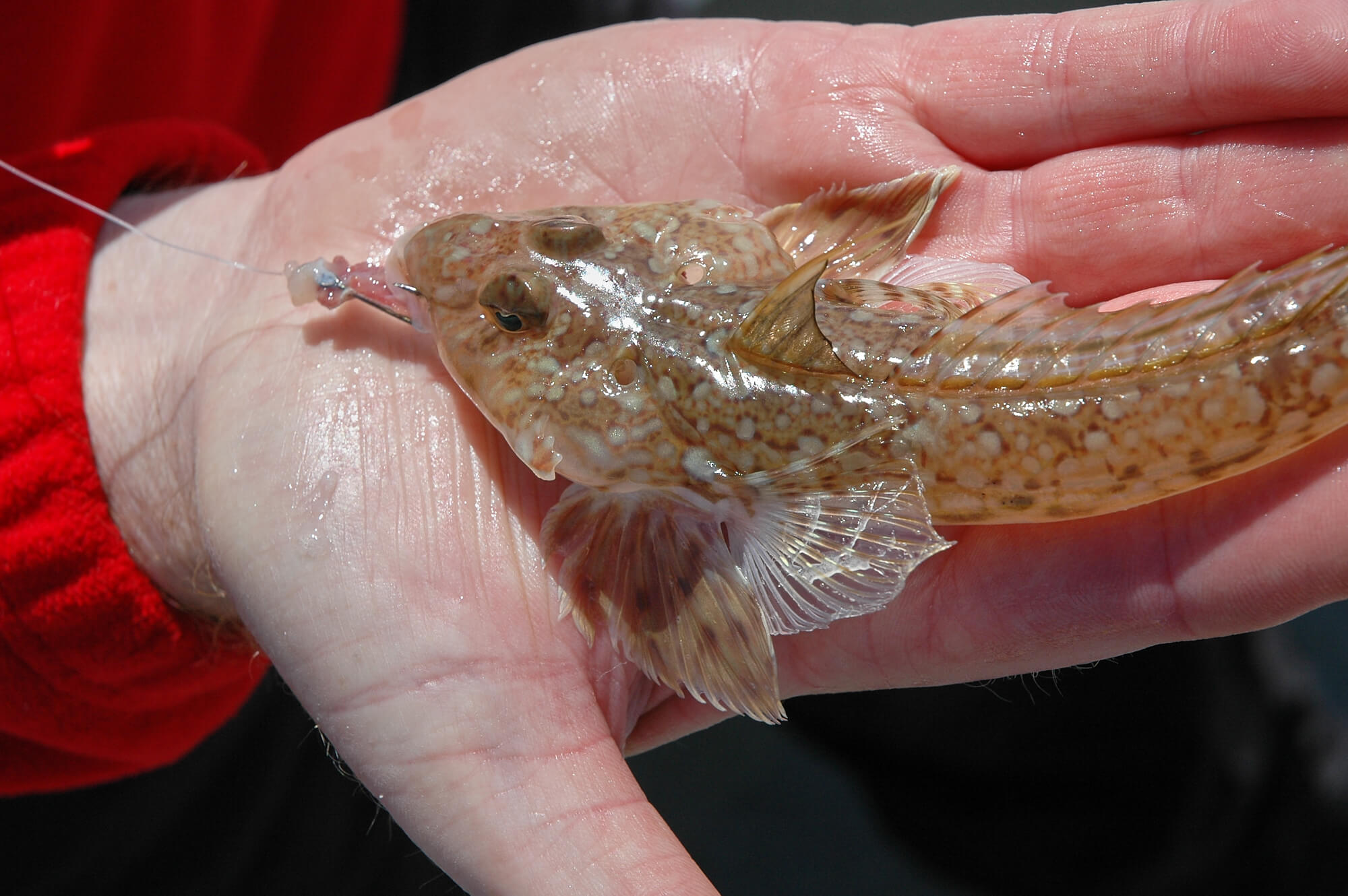 Smaller fish species like the dragonet are a staple of a gurnards diet.
Smaller fish species like the dragonet are a staple of a gurnards diet.
Another fish eater taking dragonets, flatfish, gobies and sandeels, but also swimming crabs and shrimps.
This has a more varied diet eating shrimps and swimming crabs, also dragonets, gobies, sandeels, flatfish, but also more in the way of invertebrates and is a more active hunter than the other species listed.
The diet of the streaked gurnard is more restricted to swimming crabs and deep water shrimp, but it will also take small fish.
Little is known regard’s its diet, but again it probably takes swimming crab, mysids which are small shrimp like crustaceans, small fish, also molluscs.
Information on what this gurnard eats is minimal, but again it probably exists on small crustaceans such as shrimps, small fish and molluscs.
Tides are still important when targeting gurnards, even though you’re fishing offshore. Most gurnard fishing is done on the drift, so the tide is important in that it dictates, along with the wind, just how fast you drift across the ground. If the drift is fast, you’ll need heavy leads to stay in touch with the seabed and keep your baits in the target zone. Sometimes, the two combine to make the drift just too fast to fish. During smaller tides the drift is likely to be slower and more controlled. You can also get away with lighter leads and fish the ground more effectively.
The smaller tides in many areas would be the better ones to choose then as the drift will be slower. Gurnard’s like some run in the tide though, so the best of the fishing is likely to be during the middle three hours of flood or ebbing tide. Slack water periods when flow is minimal can be dead.
If you choose spring tides, obviously the speed of the drift will be faster as water volume on the move increases and if the wind is blowing in the same direction as the tide is flowing, then the drift speed of the boat can often prove to be too much to fish. This requires you fishing the first hour or so, either side of slack water to get the best of the fishing, and just as the tide is starting to really pick up maybe.
The best conditions on the spring tides, if you have to fish them, is to have a good breeze blowing the opposite way to the tide flow. This will hold the boat up and slow the drift speed down, though you may still need to employ heavy leads to fish effectively.
If you’re fishing water under 100 feet deep, then prolonged rough seas and gales can push the gurnard’s out into deeper water. In depths over this the rough sea effect is lessened. The best days tend to be in settling or settled seas and especially if the water is carrying minimal colour.
In shallow seas, then some cloud cover is good as it reduces the light levels at depth and the fish feed better. In deep water, then it’s less of an issue as any light reaching the seabed is minimal and the fish are less affected. Even so, days with cloud cover tend to give the better catches.
Tackle choice is dictated more by the drift speed of the boat and the amount of lead weight you need to stay in contact with the seabed.
For general fishing on days when the drift is slower, then a 12lb class rod around 8ft in length is a good choice. Go for a fast taper rod with a supple tip but with plenty of power in the mid-section and with a stiff butt. Rods like this help show the bites at depth but have the backbone to lift big fish such as cod and ling, which can often take a small bait targeting gurnards.
In shallower water, say up to 100 feet, and over clean ground this rod can be matched to a 5000 sized fixed spool and loaded with 20lb braid and 20lb Fluorocarbon shock leader. It gives great sport on the smaller fish and allows you to cast away from the boat when the drift is slow to cover more ground. This rod is ideal for leads up to about 8ozs, though 6ozs gives a better balance.
In deeper water when fishing over mixed rough ground, then a 12/20lb class rod has that little bit more power to handle the bigger weights needed to fish at depths in excess of 100 to 200 feet plus. The ideal reel for this rod is a multiplier reel holding 300yds of 30lb braid and a little mono backing. Again, add a 30lb Fluorocarbon or mono leader to give a visual break from the braid and to safeguard the braid from abrasion on the seabed. This outfit is for use with 8 to 12oz leads, at a push to 1lb, which are usually enough to keep in contact with the bottom. If you need to go heavier then it’s likely that the drift speed is too fast for gurnards anyway.
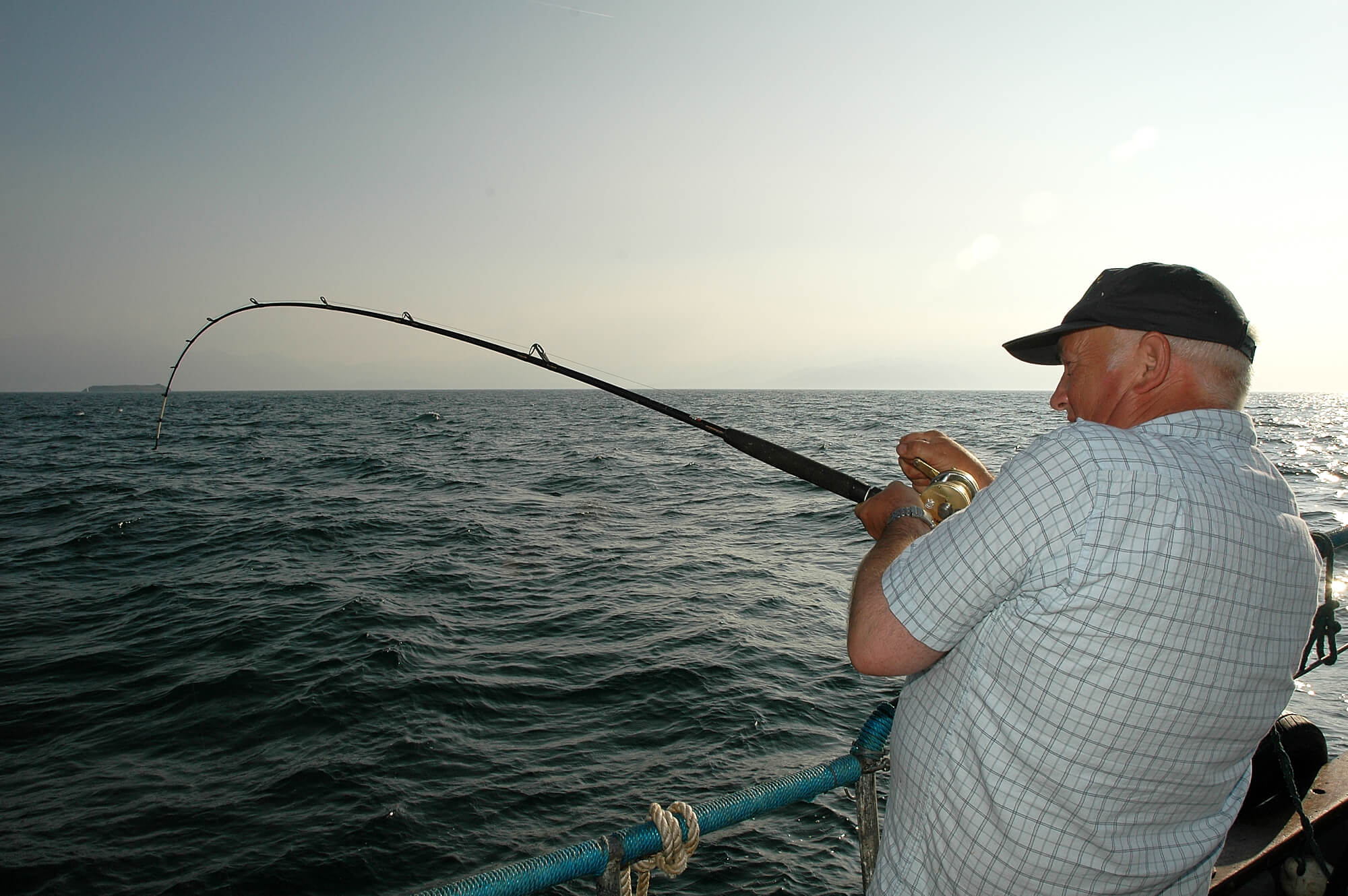
In all cases you’ll fish far more effectively if you use braid main line. For the same breaking strain this has a much lower diameter and does not catch the tide so much, so needs less lead to reach and maintain contact with the seabed. In addition, it does not stretch much, so bite detection is much improved. If you use mono, then at depth you’ll need a lot more lead to reach and hold bottom due to the higher diameter of the mono line, plus it will stretch, and bite detection will be much harder to decipher.
We would though suggest you use a shock leader on the end of the braid of Fluorocarbon, the same breaking strain as the braid. Use an Albright knot to connect the two as this is very streamlined and goes through the rod rings with minimal fuss. The shock leader needs to be twice the length of the rod. This protects the expensive braid from abrasion if it should come in contact with the seabed and gives a hint of stretch to cushion hook holds should heavier fish be hooked.
It’s important with leads, to choose designs that are bomb shaped or wholly round so that they go straight down through the water column. This means you get to the seabed fast and maximise your fishing time. Leads with flat sides, and worse bell shaped leads, will sheer off at angles during the descent slowing the speed the tackle drops down and when you’re using smaller baits this slower descent can see mackerel hit the baits in mid water and you’ll spend more time landing these than you will fishing the bottom for the gurnards.
Gurnards feed tight to the seabed. They will lift off the bottom to take food, but this is rarely more than a few feet, so it’s best to keep the rig and baits fishing as tight to the seabed as you can.
For everyday fishing, a simple set of baited feathers works especially well. The best feathers are either the silver tinfoil winged type or the silver mackerel feathers. Do though, choose feathers tied on heavier line such as 50lb to 60lb mono. The heavy line does not put off the gurnards, but it does give you some strength in the rig should other species such as ling with teeth be hooked.
Alternatively, any luminous bodied feathers, such as Hokkai’s, are brilliant for gurnard as they home in on the luminescence as the feathers move. It still pays though, to bait these with strips of mackerel. Try to get the Hokkai’s or similar patterns that are tied on the smaller 2/0 hooks. Those on bigger 4/0 hooks can see smaller to middle sized fish missed.
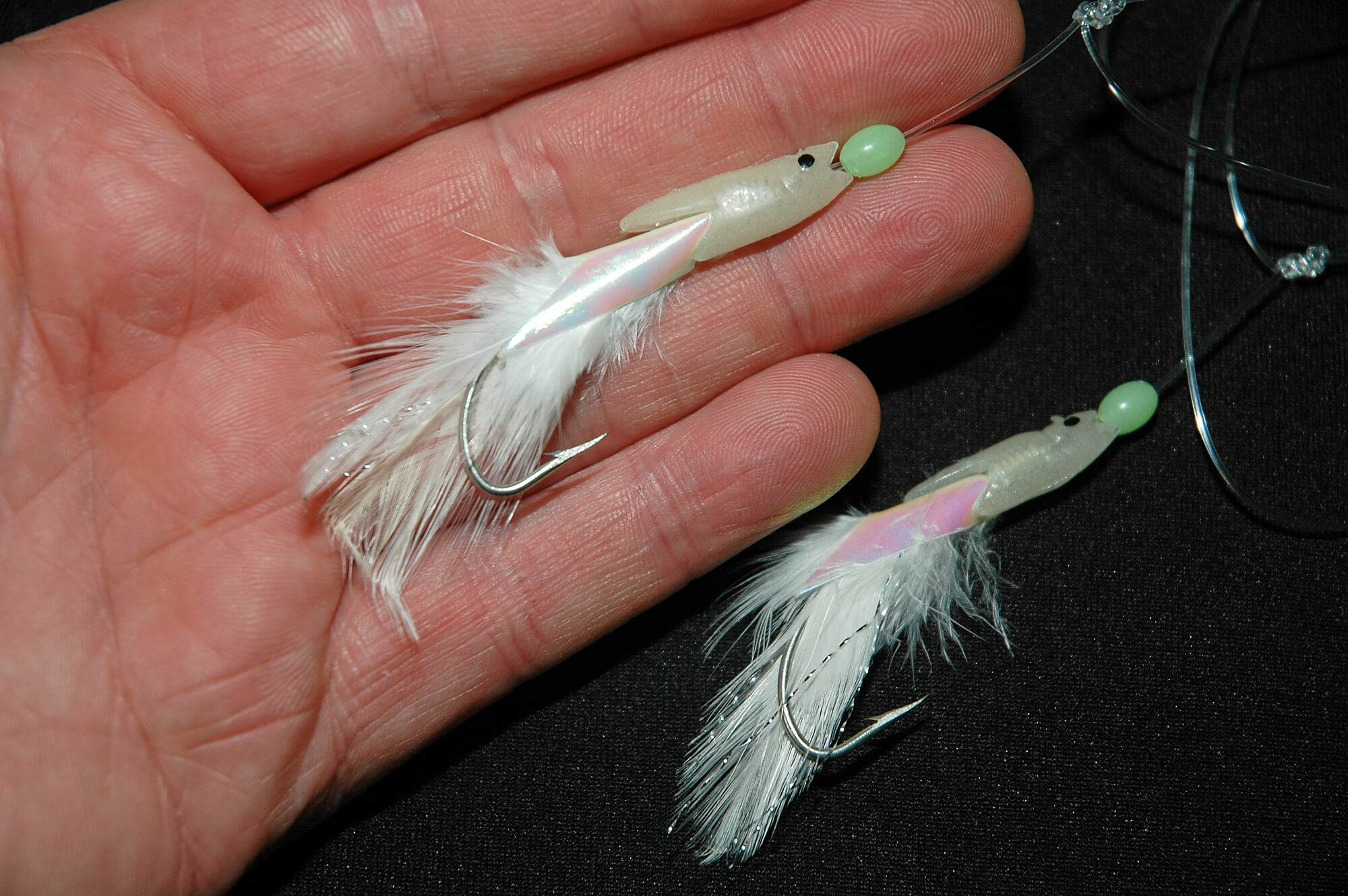
For a more targeted approach, the following rig is easy to tie but very effective when drift fishing, especially over mixed rough ground and sand.
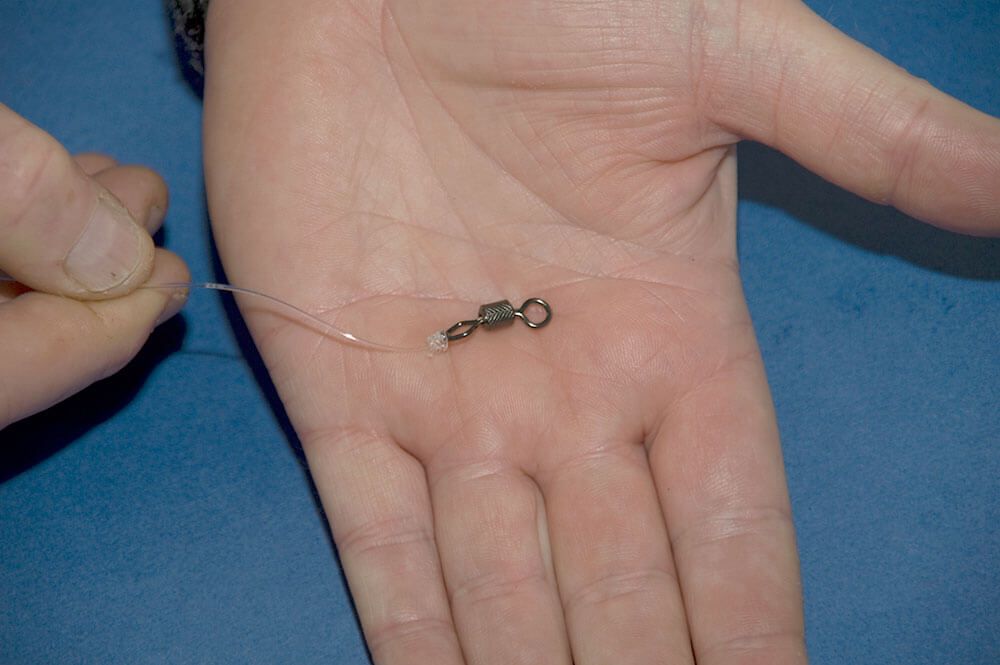
1 - Start with a size 4 rolling swivel and tie on 12-inches of 60lb clear mono.
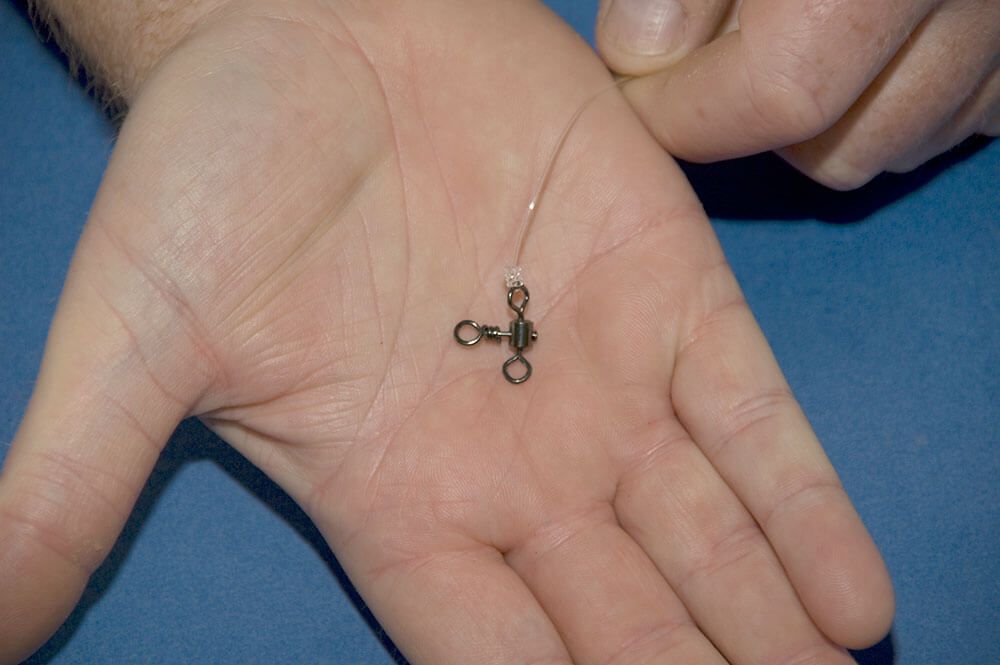
2 - To the end of the mono tie on a size 4 three way swivel by an end eye.
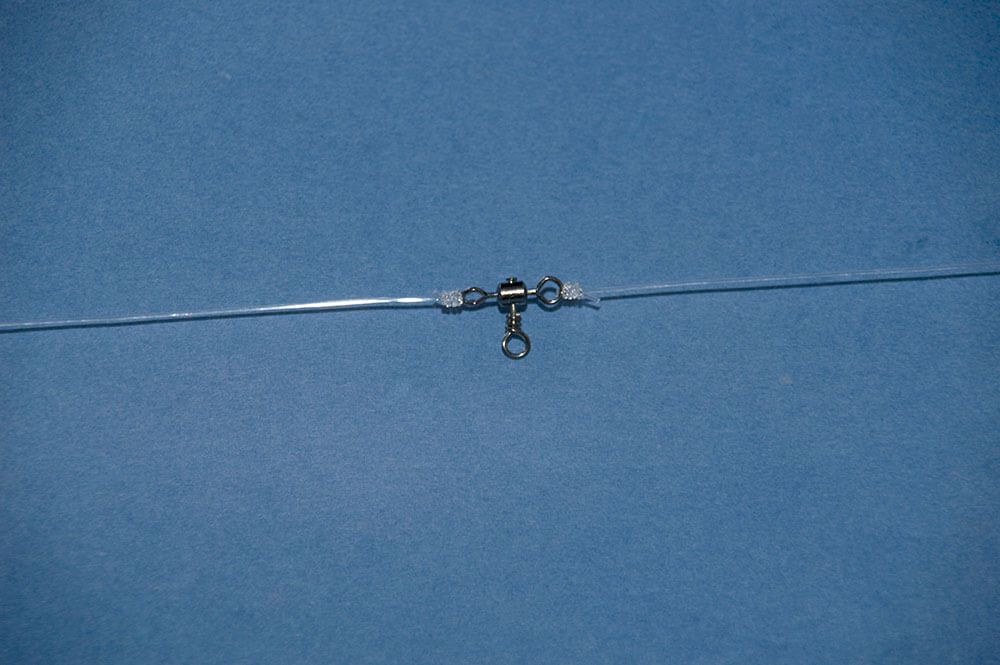
3 - To the other end swivel eye tie on 30-inches of 60lb clear mono.
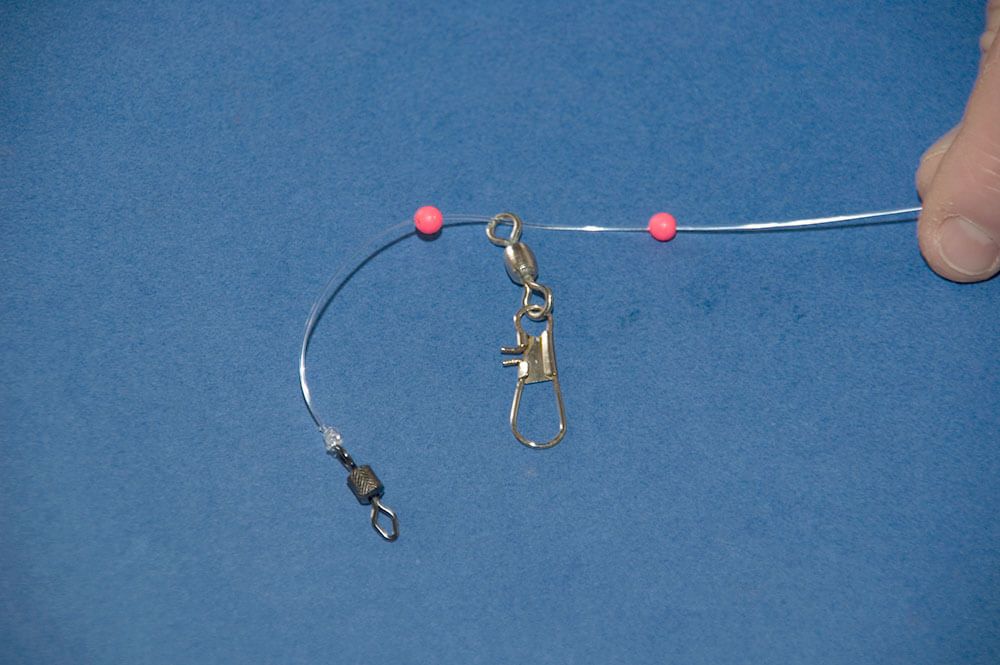
4 - Slide on a 5mm bead, a size 4 link swivel by the connector eye, another 5mm bead, then tie on a size 4 rolling swivel. The link swivel takes the lead weight.
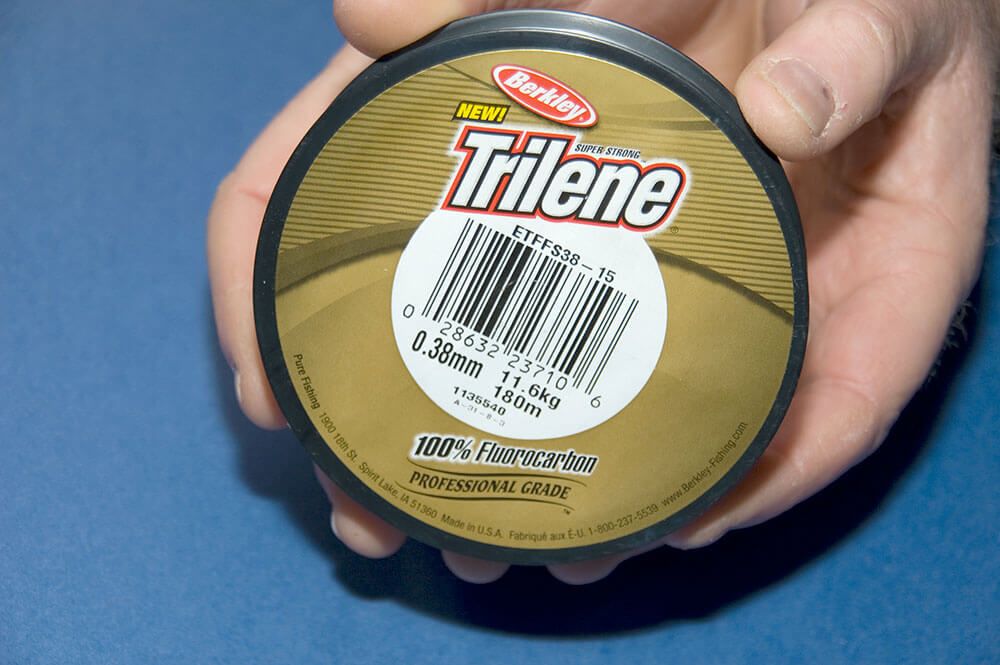
5 - The top hook trace is 10-inches of 20/25lb Fluorocarbon or clear mono tied to the middle eye of the three way swivel. The lower hook trace is 12-inches of 20/25lb Fluorocarbon or clear mono.
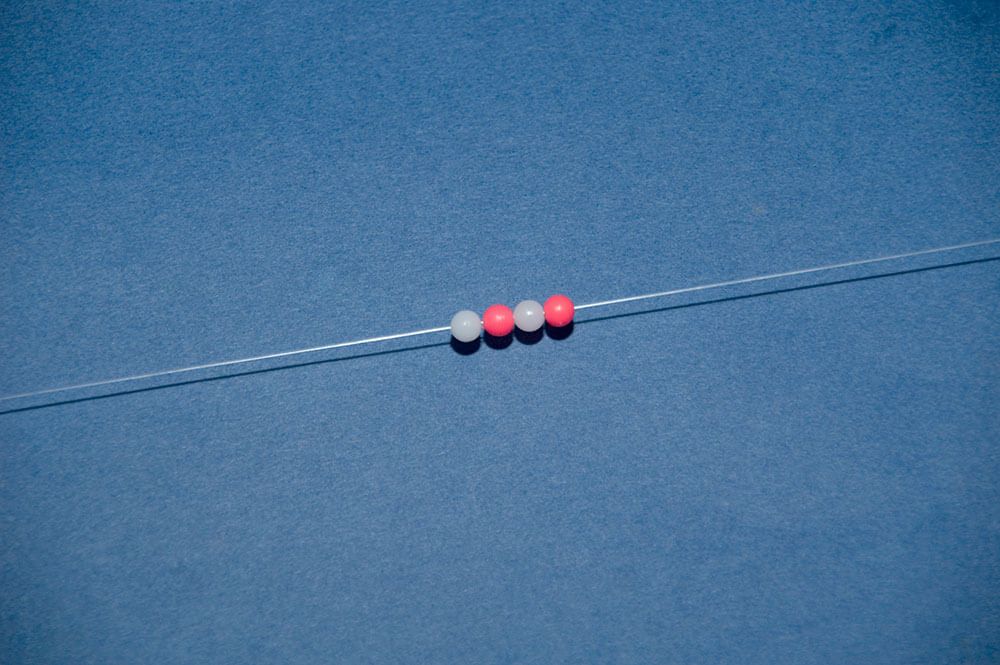
6 - To both hook lengths slide on four alternate red and white or red and pearl beads as attractors.
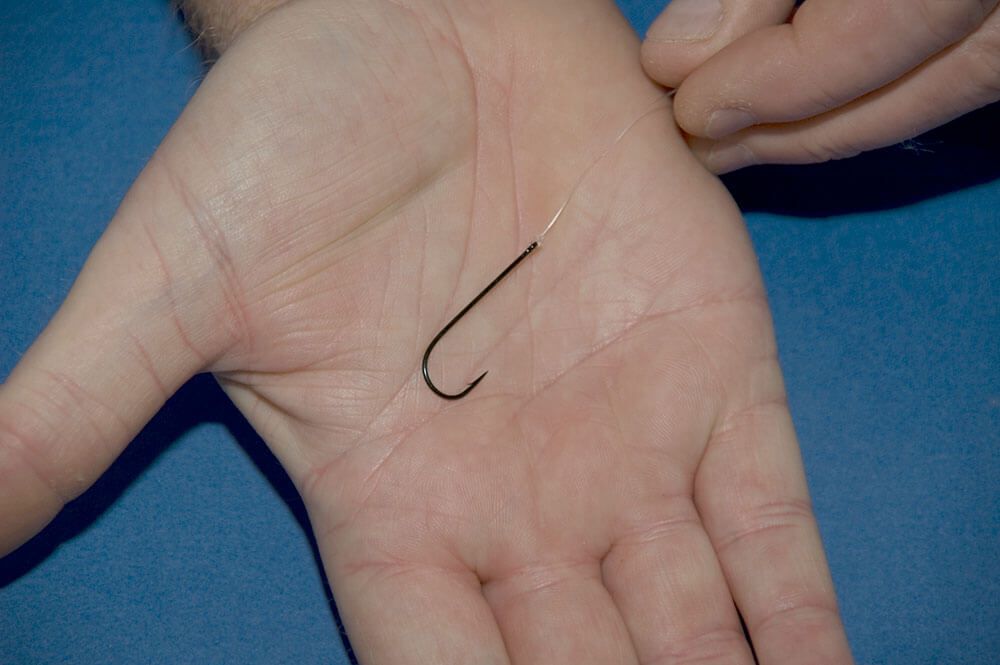
7 - To finish off the right tie on a Kamasan B940 Aberdeen’s size 2 or Sakuma equivalents, which are a favourite patterns for general fishing, but for specimen fish go up to a size 2/0.
This completes the 2 Hook Gurnard Drifting rig, to see the rig in full visit the Gurnard Drifting Rig Page here and for other rigs, please visit our Sea Fishing Rigs pages.
Long shank Aberdeen hooks are the best choice. The gurnards have big mouths and can easily swallow baits, so the long shank helps keep the hook towards the front of the jaws for easy unhooking as gurnards will go back alive well even when caught from depth. Short shank hooks encourage deep hooking and we need to avoid this. The other advantage with a long shank is that small ling are also likely to be caught on the mackerel strip and the long shank of the hook helps protect the mono or Fluorocarbon.
Red and white or red and pearl beads seem to make a positive difference to the catch rate. This especially applies to shallow water up to 100 feet or so and in clear water conditions. At greater depths, instead of the white beads, change them for luminous green ones. Gurnards really like luminous green as they see it lifting and lowering in the water and move in to investigate then take the bait.
Gurnards also like spinning spoons. The best ones are the small plastic disc spoons. Add one of these, they only need to be about an inch in length, directly above the beads so that it turns freely. Good colours for all gurnards are red or silver. Gurnards will tend to pick up the vibration of these as they turn in the water and this will also draw them into the baits.
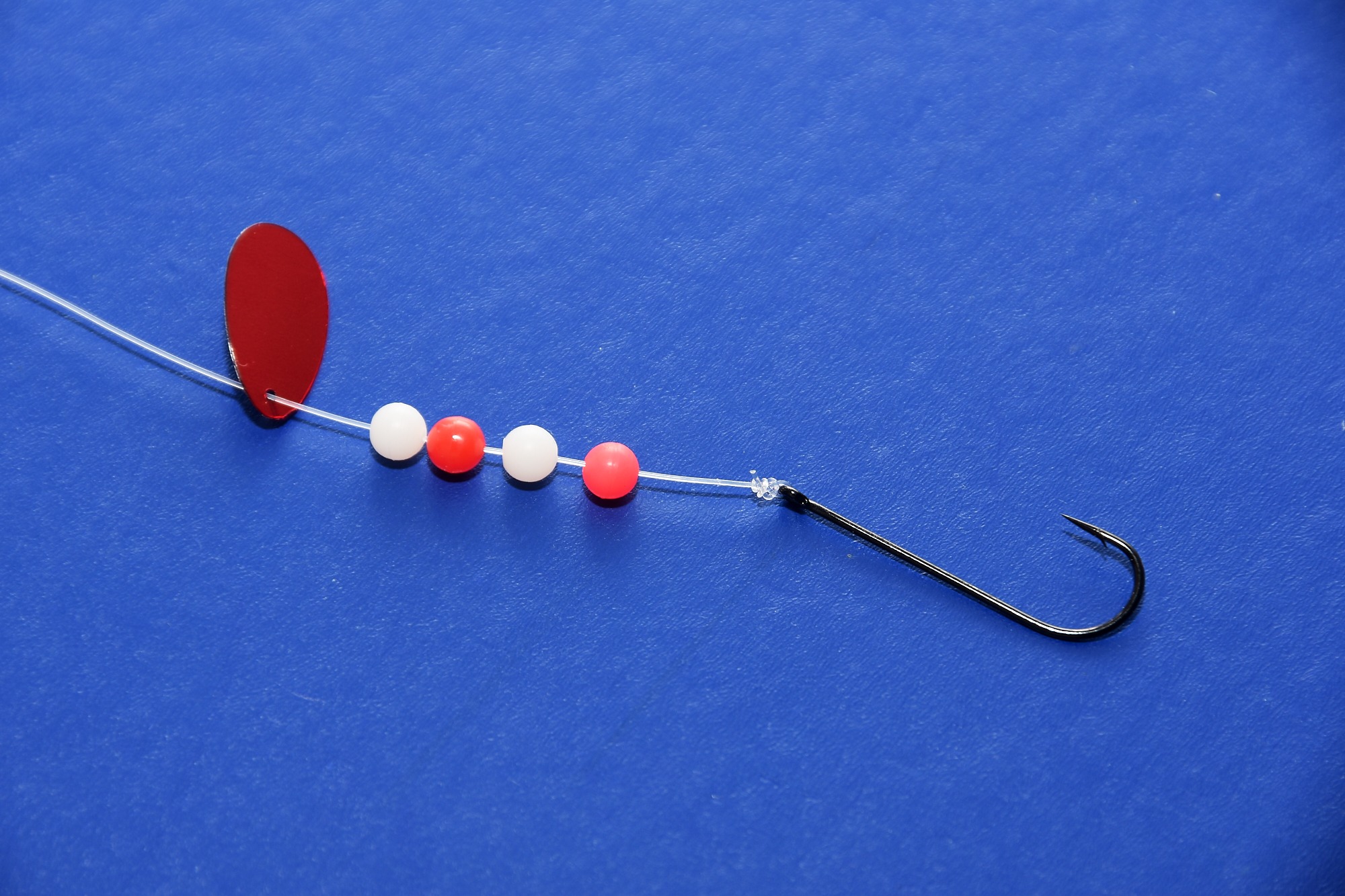
Another good rig in deep water is a three hook rig using shorter 8-inch hook lengths, but sliding a small pink muppet, the smallest you can get, or a short length of luminous pink tubing onto the line and hook, and again adding bait. This pink colour is deadly in deeper water, especially for tub gurnards which are very predatory.
A trick to avoid losing too much tackle when tripping the lead over the seabed, is to use a short section of slightly lighter mono line. This only needs to be about 6-inches long and it’s tied to the lead link on the base of the rig and then the lead weight is tied to this lighter line. An example would be using an 18lb weak link with 30lb braid and leader. If you get the lead snagged, then pointing the rod directly down the line and holding the spool with the thumb will either see the lead pull free or the weak link break. If it’s the latter, at least you get the rig back to minimise losses.
For most of your gurnard fishing fresh mackerel will be the number one bait. Baits need to be slivers or strips about 2ins long and no more than a half inch wide. All cuts will catch fish, but the best is the white belly section, maybe because the eyesight of the gurnards at depth is better than we think, and it imitates a small fish. Bigger slivers up to 3ins will be taken, but you do begin to reduce catches when using bigger baits, so bear this in mind. Strips of herring can be good too, and these are cut the same as mackerel.
A good tip when cutting these thin neat strips of mackerel belly is to carry with you a plastic Stanley knife. These are ultra-sharp and way better than a standard knife for cutting neat, thin baits. Shops like LIDL sell small cutting boards about 7ins long by 5ins wide. These take up no room in your box but are perfect for cutting the thinner belly strips when using the Stanley knife. Neat baits will present better and the Talk Sea Fishing team have noticed many times that neat baits catch more gurnards.
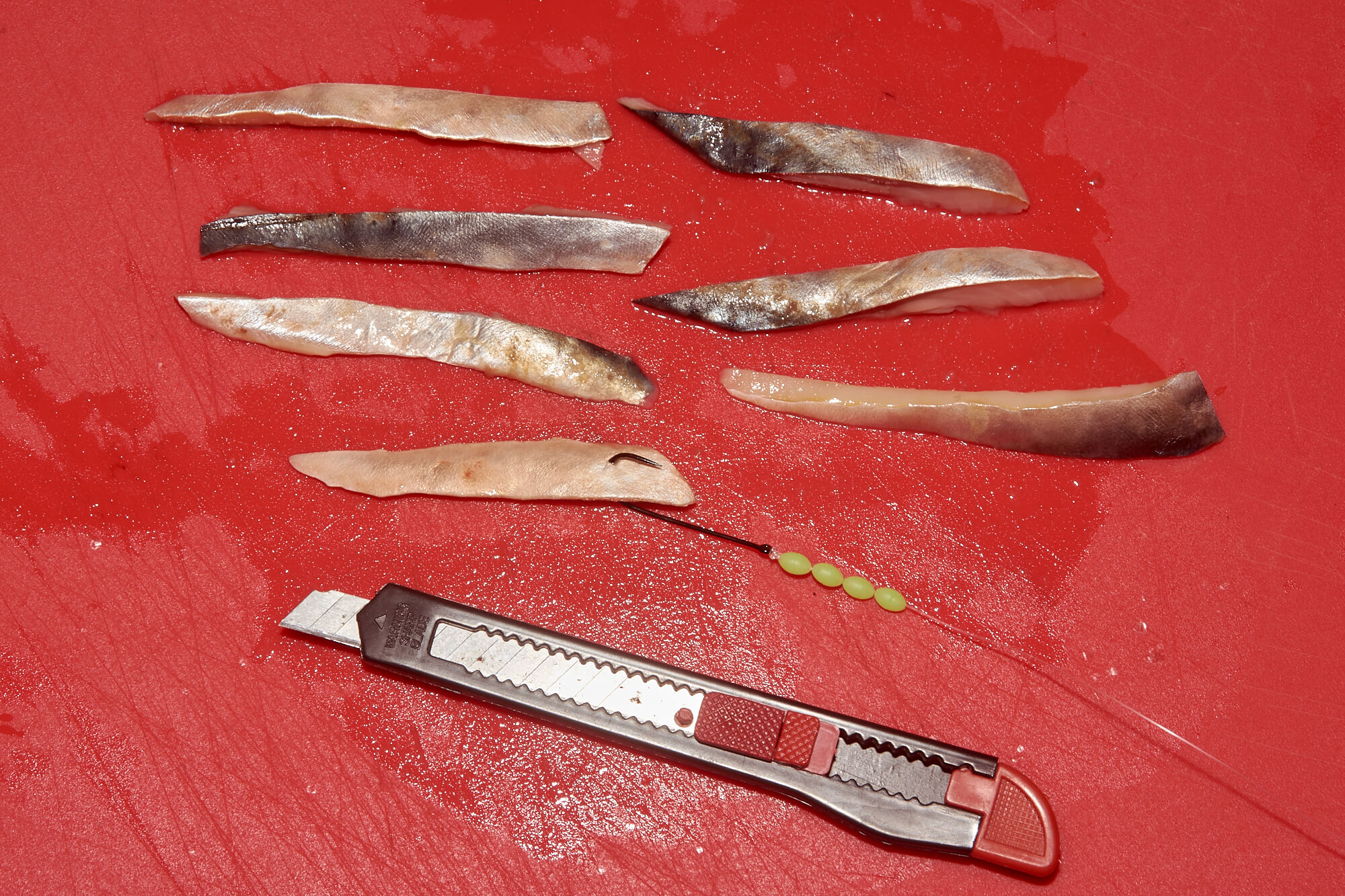
To present these it’s enough to just pass the hook point through the flesh side once at the top of the bait and bring it fully through the skin. This means the strip can fish cleanly in a straight manner and will not roll around unnaturally when drift fishing.
Sandeel is a good bait, either whole mounted through the head and the hook midway through the body and the tail cut off to stop it spinning, or in body sections about 2-ins long. If you have access to bigger launce sandeel, then a strip cut the same as for the mackerel also works well.
Gurnards will take ragworm and even lug baits, also mussels, but neither of these are as effective as the fish baits are.
When you start the drift, as the lead weight hits the bottom, lift the rod tip up immediately and hold the lead just up off the bottom. If the line starts to stream away and the angle of the line shallows, then you need a heavier lead weight. Do this until you find a weight heavy enough to just stay in contact with the seabed. You need to be able to feel the weight occasionally bounce on the sand or rock proving you are tight to the seabed. It’s important to only use just enough lead to keep in contact with the seabed so be prepared to constantly change the weight of the lead as the tide flow changes. As the tide changes and the boats drift speed increases you will need to use a heavier lead. Equally, as the drift speed decreases you need to change to a lighter lead. This is important as it aids bite detection especially when fishing deeper water.
Once you are able to constantly tap bottom, hold the rod and feel for bites. Gurnards bite as a fast rattle, though sometimes a bigger fish will just pull the rod tip over. They usually hook themselves and it’s enough to just let the rod tighten into them as you feel the bite.
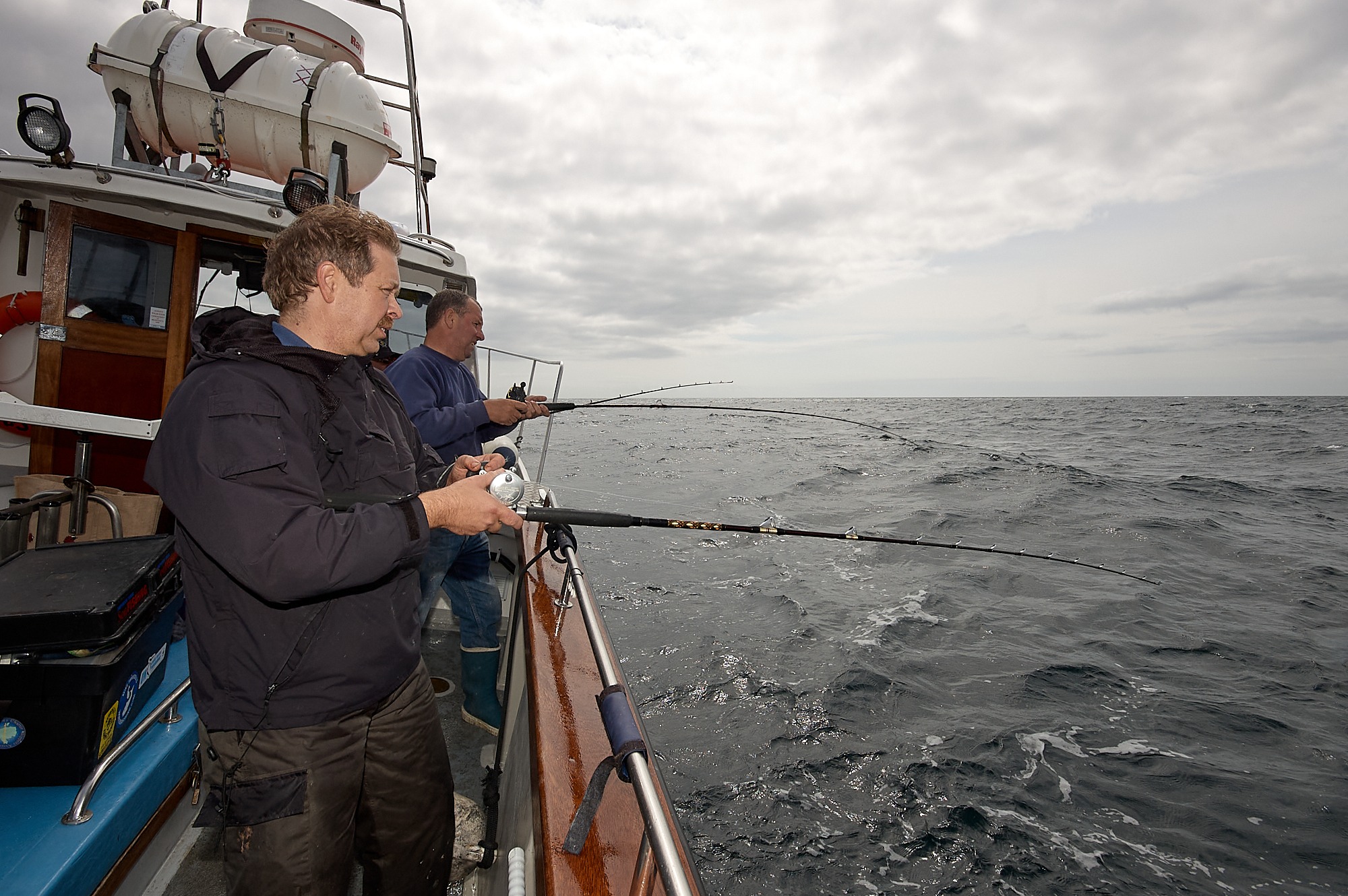
If the drift is slow, then occasionally lift the rod tip up a few feet then drop it back. This lifts the bait up off the seabed and it will flutter back down as the weight hits bottom. This is a deadly tactic for gurnards who tend to take as the bait is fluttering down.
If the drift is slow and you’re over rougher ground a very good tactic, especially for tub gurnard, is to deliberately keep lifting and dropping the rod tip to bounce the lead weight on the rocks. This rhythmic tapping noise will bring the inquisitive gurnards in to see what’s happening and they’ll take the bait.
Gurnards will not chase baits that move erratically if the drift is quick. This is why we use short 12-inch hook lengths on the drift rig we described. The best way to catch gurnards is to have the bait hard on the seabed and moving predictably, so the short hook length keeps that bait in the gurnards feeding zone and tripping along the seabed exactly where the gurnards are looking for their food. The easier a target their prey is, the better they like it.
In deeper water, a good edge is to use luminous lead weights. The brighter luminous green ones are best, but orange can work well for gurnards, as can yellow and white, but it tends to be an on the day thing and you need to experiment, but it’s well worth doing and is a trick boat match anglers often use to increase catches. When the gurnards see the moving luminous lead pass by it also draws their eye to the moving baits. Another thought is that it makes them more aggressive in taking the bait. Maybe the bright moving bait sees them thinking that another predator is taking bait they could eat and they become more competitive.
[*]Over slack water when there is little drift speed, try lengthening the lower hook trace on the drift rig described to 20-inches and bounce that lead weight on the seabed. This extra movement of the bait can often induce a gurnard to hit the bait as it falls back to the seabed and comes to rest.[*]When you’re using luminous tubing, Hokkai lures or luminous beads, these work better if you charge them using the flash on your phone, or better still a UV torch. Holding them in the sun also works, but it takes longer for the luminous product to charge via bright sunlight. The sudden intense shock of light from a flash does it much quicker.[*]Don’t be tempted to leave old bait on the hook. Once it becomes washed out after fishing for say 10 minutes, then retrieve and re-bait with fresh. None of the gurnards like stale bait, they prefer fresh strips with plenty of blood and oil streaming from it. [*]When fishing inshore over clean sand, and especially if the day is bright and the sea fairly clear with a slow boat drift speed, try using a watch lead instead of a plain lead. These have raised bumps on them, and these rip up the surface sand as the boat drifts along. This creates little puffs of sand which will be seen by the ever observant gurnards and they’ll move in to investigate. [/list]
About gurnards
Gurnards are too often classed as a by-catch by some sea anglers, tending to turn up when fishing for other bottom species. This though, is a blinkered view as gurnards are one of the best looking fish, you’re likely to catch, and in the case of the tub gurnard they can reach a good size, too.
With so many sea anglers now having both annual and life-time species list, gurnards are becoming a popular specific target and it’s worth exploring the various tactics available to us that can produce both higher numbers of gurnards, but also target those bigger specimen sized fish.
Identification
There are six gurnards in British and Irish waters. Three are common, one uncommon, and two very rarely caught on rod and line.
We’ll ID all six, but will concentrate on the tub, grey and red which are targetable, whereas the other three, the streaked gurnard, long-finned gurnard and piper are rarely caught on rod and line and can be classed as “lucky” fish if you do catch one.
Tub Gurnard
The tub gurnard has a pointed snout with the front edge carrying two small lobes featuring small spines on the leading edge. The lateral line has small scales and the body scales are small. The main at a glance means of identifying this fish is to check the pectoral fin which reaches well past the vent and well beyond the second dorsal and anal fins forward edge.
Its colouration is also distinctive with the pectoral fins being a bright blue with green or dark spots and the fin edges sometimes tinted in red. The back mixes from bright red or pink shading to orange and then a silver white belly, though this can also be a flushed pink on fish living in deeper water.
The tub is the biggest of our gurnards reaching a plausible weight of around 12lbs. Fish in the 3lbs to 5lbs range are not uncommon if specifically targeted in UK and Irish waters. A fish weighing 4lbs 8ozs would currently be classed as a specimen sized fish
Little known is that tub gurnards are a small shoal fish forming groups of up to 20 fish. However, larger specimens tend to be solitary, or in two’s and three’s indicating these may be the last survivors of the original shoal.

Grey Gurnard
The grey gurnard is a more slender bodied fish with a sharply pointed snout. The angle of the head is straight, unlike the other gurnards which show a distinct dishing in the angle of the front of the head. The pectoral fins do not reach the vent, so use this as a quick form of identification. The lateral line also has sharp and bony scutes that catch the skin when rubbed.
The back and flanks of this fish are a dull grey sometimes with a brown or beige tinge and littered with tiny white or creamy spots. Also look for a dark blotch or spot positioned on the top middle of the first dorsal fin.
It’s rare for a grey gurnard to reach over 3lbs in weight, but a 1.5lb fish can be classed a specimen sized.
Although not classed as a shoaling fish, they are often found in numbers on specific areas of ground best suited to them, but few and far between relatively close by where a ground feature change is evident.

Red Gurnard
This gurnard has a deeper set body shape with more obvious body scales. The lateral line has no sharp spines but is defined by a line of larger scales running right to the tail lobe. When the pectoral fin is laid flat along the body, its tip only just reaches beyond the start line of the anal fin and only just reaches the vent.
The colouration of this gurnard is the giveaway as the name suggests, it being bright red overall with reddy orange sides and a flushed pinky white belly. The ventral fins are pale but with dark at the edges.
The red is one of the smallest gurnards reaching a size of about 3lbs, though bigger fish have been recorded. Your specimen target weight is 2lbs.
It is the least caught of the more common gurnards found in our waters as its habitat is more specifically defined but can be common locally.

Streaked Gurnard
This is a noticeably much heavier bodied gurnard with a more blunt angle to the head. The lateral line scales have small skin catching points, with the body sporting obvious ridges of skin originating from the lateral line.
The colouration is a dull red to reddish brown back, sometimes with darker patches evident fading into a white belly. The pectoral fins may cause confusion with the tub gurnard being greyish with a red tinge to the edges but with rows of bright blue spots.
It rarely reaches 2lbs in weight and being a deeper water gurnard, it is an uncommon catch.
Long Finned Gurnard
A relatively slender bodied gurnard with a more convex or rounded head than the others. It has a single small spine on each side of the mid-line at the point of the snout. The ID feature for this fish is the long second spine on the first dorsal fin which is visually elongated and twice as long as the other spines, plus it’s thicker at the base. The lateral line is also defined by large flexible scales.
The back is reddish brown and the belly shades to pinkish on the underside. Also look for the lateral line which is pearl-pink in colour and obvious.
Piper Gurnard
The snout is formed into two flattened plates, one each side, with distinct forward pointing teeth, which are the quick means of identification. Just above the pectoral fin also note a large pointed spine, with the other head spines also well developed. The lateral line is smooth, but the body is covered by fine but rough-edged scales. The dorsal fin has sharp spines, but the lateral line is smooth to the touch.
Colour wise this fish can be confused with the red gurnard as the piper is a bright red overall colour fading to a lighter red flush on the forward belly, but pinkish silver around the abdomen.
Distribution
Tub Gurnard
Tub gurnards are found throughout the Mediterranean, North Africa, up the Spanish, Portuguese and French coast, all around the UK and Ireland, and up as far as the middle of Norway. They are most common on the Atlantic facing coasts and less common, almost non-existent in the northern half of the North Sea.
The very best area for big tub gurnards is either off the southern tip of Cornwall and the Scilly Islands, but especially off the Kerry, Galway, Mayo and Donegal coast in the west of Ireland.
Grey Gurnard
This species has a much wider range than its cousin the tub, being found throughout the Mediterranean and Black Sea, right up the west coast of Europe to middle Norway, and it’s also found off the southern coast of Iceland with localised pods of fish situated between The Faroes and Iceland in the open ocean, this recorded by commercial fishing catches.
It is found throughout the UK, but again is more prominent on the west facing coasts, and throughout Ireland, again the west seeing the biggest numbers and the bigger fish generally.
Red Gurnard
Although found in the Mediterranean they are less common in the east of this region. Also, though present off the European west coast, they are rarely seen north of the Dutch coast and are pretty much absent from the middle and north of the North Sea.
Their numbers around the UK are concentrated from the English Channel, right up the west coast and throughout the Irish Sea, up as far as the western mouth of the Pentland Firth. They are not present off the northeast coasts of England or Scotland.
They are caught all around Ireland, but the bigger fish and better numbers are on the Atlantic coast with the more northern counties of Mayo and Donegal giving the very best chance of a specimen fish.
Streaked Gurnard
Although catches indicate they are present throughout the Mediterranean and the upper tip of North Africa, also the western facing European coast as far as Holland, they are very rare in the southern sector of the English Channel and less so along the west coast, but have been caught in the Irish Sea and off the west of Ireland as far up as Donegal.
It’s usually after a mild winter and a warm spring that these fish show in late summer in our waters with warmer than usual sea temperatures being the main contributor.
Long-Finned Gurnard
This gurnard is restricted to the western side of the Mediterranean, partially down the North African coast, and up the European coast as far as the Brest Peninsula. This is a very rare catch in UK waters and the only real chance is when fishing off the Devon and Cornish coast.
Piper Gurnard
Although found halfway down the west Africa coast, its densest population is in the northern sector of the Mediterranean and up the west European coast as far as the Brest Peninsula. This is a deep water gurnard, so is only found towards the continental shelf and unlikely to be caught by rod and line anglers. There may be a chance off the south west and west coast of Ireland from ports such as Union Hall, Castletownbere, or Cahersiveen, maybe off the Galway Coast but this would be a very long shot.
Habitat
Tub Gurnard
Juveniles less than a pound in weight can be found close to shore in just a few metres of water up to about 60 feet, but adult tubs are found in water down to about 500 feet or 165-metres but are commonest in depths between 80 feet and 250 feet.
Inshore they favour sandy ground, or sometimes muddy bottoms. The adult fish in deeper water are found on sandy bottoms but tend to be relatively close to rougher ground such as reefs. The biggest fish prefer the sandy patches right in amongst the rough ground using the rough to break the tidal flow over them and provide ambush points to target prey from.
Grey Gurnard
The grey gurnard, mainly the very small juveniles a few inches long, also frequent the shallow waters occasionally, and they especially seem to favour calmer areas such as marinas and harbours feeding over clean sand and mud. The bigger fish though, in contrast, prefer deeper water and are not commonly found in water less than 75 feet and tend to be concentrated in better numbers in water in excess of 100 feet to 250 feet deep. They are also taken though, in depths exceeding 500 feet.
They are found over sand offshore, but will also frequent areas of shell, stone and even live right in amongst the rough ground reef feature.
Red Gurnard
This gurnard can deceive, and smaller fish can be taken in inshore waters in depths of 25 feet when fishing off cliffs and rocks but is more generally found offshore in depths of 100 feet to 300 feet but is found down to depths of 700 feet or more.
They tend to prefer rough ground well mixed with cleaner sand or gravel patches but will also be taken on shell and grit banks that form where a tide run is deflected by rising reef ground. Big red gurnards can also often be caught near wrecks, too.
Streaked Gurnard
This is a deep water gurnard most often found in depths in excess of 150 to 300 feet. It favours cleaner sand and gravel, but again will take up station in amongst reef ground on cleaner patches.
Long-Finned Gurnard
Favours shallower water than the other gurnards and its numbers are concentrated in depths from 5 to 150 feet. It also prefers rocky ground such as reefs and extensive areas of broken boulder and bedrock.
Piper Gurnard
Due to the piper’s preference for very deep water out towards the upper continental shelf in depths of at least 1000 feet and often deeper than 2000 feet, there is very little known of its habits and preferences, other than it is caught mostly over a muddy seabed.
Diet
Tub Gurnard
This is a true predator and eats mainly fish such as sandeels, gobies, flatfish, dragonets and even its own kind. Other staple food items are whiting and codling. It has a big mouth and will take quite large items compared to its own body size. It will also take crustaceans such as swimming crabs, brown shrimps, and squat lobsters.
All the gurnards have feelers under the chin that they use to poke through the sand and mud to feel out and taste potential food. They also walk on these feelers when searching for food.

Grey Gurnard
Another fish eater taking dragonets, flatfish, gobies and sandeels, but also swimming crabs and shrimps.
Red Gurnard
This has a more varied diet eating shrimps and swimming crabs, also dragonets, gobies, sandeels, flatfish, but also more in the way of invertebrates and is a more active hunter than the other species listed.
Streaked Gurnard
The diet of the streaked gurnard is more restricted to swimming crabs and deep water shrimp, but it will also take small fish.
Long-Finned Gurnard
Little is known regard’s its diet, but again it probably takes swimming crab, mysids which are small shrimp like crustaceans, small fish, also molluscs.
Piper Gurnard
Information on what this gurnard eats is minimal, but again it probably exists on small crustaceans such as shrimps, small fish and molluscs.
Tides for gurnard fishing
Tides are still important when targeting gurnards, even though you’re fishing offshore. Most gurnard fishing is done on the drift, so the tide is important in that it dictates, along with the wind, just how fast you drift across the ground. If the drift is fast, you’ll need heavy leads to stay in touch with the seabed and keep your baits in the target zone. Sometimes, the two combine to make the drift just too fast to fish. During smaller tides the drift is likely to be slower and more controlled. You can also get away with lighter leads and fish the ground more effectively.
The smaller tides in many areas would be the better ones to choose then as the drift will be slower. Gurnard’s like some run in the tide though, so the best of the fishing is likely to be during the middle three hours of flood or ebbing tide. Slack water periods when flow is minimal can be dead.
If you choose spring tides, obviously the speed of the drift will be faster as water volume on the move increases and if the wind is blowing in the same direction as the tide is flowing, then the drift speed of the boat can often prove to be too much to fish. This requires you fishing the first hour or so, either side of slack water to get the best of the fishing, and just as the tide is starting to really pick up maybe.
The best conditions on the spring tides, if you have to fish them, is to have a good breeze blowing the opposite way to the tide flow. This will hold the boat up and slow the drift speed down, though you may still need to employ heavy leads to fish effectively.
Weather Patterns
If you’re fishing water under 100 feet deep, then prolonged rough seas and gales can push the gurnard’s out into deeper water. In depths over this the rough sea effect is lessened. The best days tend to be in settling or settled seas and especially if the water is carrying minimal colour.
In shallow seas, then some cloud cover is good as it reduces the light levels at depth and the fish feed better. In deep water, then it’s less of an issue as any light reaching the seabed is minimal and the fish are less affected. Even so, days with cloud cover tend to give the better catches.
Tackle for gurnard fishing
Tackle choice is dictated more by the drift speed of the boat and the amount of lead weight you need to stay in contact with the seabed.
For general fishing on days when the drift is slower, then a 12lb class rod around 8ft in length is a good choice. Go for a fast taper rod with a supple tip but with plenty of power in the mid-section and with a stiff butt. Rods like this help show the bites at depth but have the backbone to lift big fish such as cod and ling, which can often take a small bait targeting gurnards.
In shallower water, say up to 100 feet, and over clean ground this rod can be matched to a 5000 sized fixed spool and loaded with 20lb braid and 20lb Fluorocarbon shock leader. It gives great sport on the smaller fish and allows you to cast away from the boat when the drift is slow to cover more ground. This rod is ideal for leads up to about 8ozs, though 6ozs gives a better balance.
In deeper water when fishing over mixed rough ground, then a 12/20lb class rod has that little bit more power to handle the bigger weights needed to fish at depths in excess of 100 to 200 feet plus. The ideal reel for this rod is a multiplier reel holding 300yds of 30lb braid and a little mono backing. Again, add a 30lb Fluorocarbon or mono leader to give a visual break from the braid and to safeguard the braid from abrasion on the seabed. This outfit is for use with 8 to 12oz leads, at a push to 1lb, which are usually enough to keep in contact with the bottom. If you need to go heavier then it’s likely that the drift speed is too fast for gurnards anyway.

In all cases you’ll fish far more effectively if you use braid main line. For the same breaking strain this has a much lower diameter and does not catch the tide so much, so needs less lead to reach and maintain contact with the seabed. In addition, it does not stretch much, so bite detection is much improved. If you use mono, then at depth you’ll need a lot more lead to reach and hold bottom due to the higher diameter of the mono line, plus it will stretch, and bite detection will be much harder to decipher.
We would though suggest you use a shock leader on the end of the braid of Fluorocarbon, the same breaking strain as the braid. Use an Albright knot to connect the two as this is very streamlined and goes through the rod rings with minimal fuss. The shock leader needs to be twice the length of the rod. This protects the expensive braid from abrasion if it should come in contact with the seabed and gives a hint of stretch to cushion hook holds should heavier fish be hooked.
It’s important with leads, to choose designs that are bomb shaped or wholly round so that they go straight down through the water column. This means you get to the seabed fast and maximise your fishing time. Leads with flat sides, and worse bell shaped leads, will sheer off at angles during the descent slowing the speed the tackle drops down and when you’re using smaller baits this slower descent can see mackerel hit the baits in mid water and you’ll spend more time landing these than you will fishing the bottom for the gurnards.
Gurnard Fishing Rigs
Gurnards feed tight to the seabed. They will lift off the bottom to take food, but this is rarely more than a few feet, so it’s best to keep the rig and baits fishing as tight to the seabed as you can.
For everyday fishing, a simple set of baited feathers works especially well. The best feathers are either the silver tinfoil winged type or the silver mackerel feathers. Do though, choose feathers tied on heavier line such as 50lb to 60lb mono. The heavy line does not put off the gurnards, but it does give you some strength in the rig should other species such as ling with teeth be hooked.
Alternatively, any luminous bodied feathers, such as Hokkai’s, are brilliant for gurnard as they home in on the luminescence as the feathers move. It still pays though, to bait these with strips of mackerel. Try to get the Hokkai’s or similar patterns that are tied on the smaller 2/0 hooks. Those on bigger 4/0 hooks can see smaller to middle sized fish missed.

For a more targeted approach, the following rig is easy to tie but very effective when drift fishing, especially over mixed rough ground and sand.
How to build a 2-hook Gurnard Drift Fishing Rig

1 - Start with a size 4 rolling swivel and tie on 12-inches of 60lb clear mono.

2 - To the end of the mono tie on a size 4 three way swivel by an end eye.

3 - To the other end swivel eye tie on 30-inches of 60lb clear mono.

4 - Slide on a 5mm bead, a size 4 link swivel by the connector eye, another 5mm bead, then tie on a size 4 rolling swivel. The link swivel takes the lead weight.

5 - The top hook trace is 10-inches of 20/25lb Fluorocarbon or clear mono tied to the middle eye of the three way swivel. The lower hook trace is 12-inches of 20/25lb Fluorocarbon or clear mono.

6 - To both hook lengths slide on four alternate red and white or red and pearl beads as attractors.

7 - To finish off the right tie on a Kamasan B940 Aberdeen’s size 2 or Sakuma equivalents, which are a favourite patterns for general fishing, but for specimen fish go up to a size 2/0.
This completes the 2 Hook Gurnard Drifting rig, to see the rig in full visit the Gurnard Drifting Rig Page here and for other rigs, please visit our Sea Fishing Rigs pages.
Long shank Aberdeen hooks are the best choice. The gurnards have big mouths and can easily swallow baits, so the long shank helps keep the hook towards the front of the jaws for easy unhooking as gurnards will go back alive well even when caught from depth. Short shank hooks encourage deep hooking and we need to avoid this. The other advantage with a long shank is that small ling are also likely to be caught on the mackerel strip and the long shank of the hook helps protect the mono or Fluorocarbon.
Red and white or red and pearl beads seem to make a positive difference to the catch rate. This especially applies to shallow water up to 100 feet or so and in clear water conditions. At greater depths, instead of the white beads, change them for luminous green ones. Gurnards really like luminous green as they see it lifting and lowering in the water and move in to investigate then take the bait.
Gurnards also like spinning spoons. The best ones are the small plastic disc spoons. Add one of these, they only need to be about an inch in length, directly above the beads so that it turns freely. Good colours for all gurnards are red or silver. Gurnards will tend to pick up the vibration of these as they turn in the water and this will also draw them into the baits.

Another good rig in deep water is a three hook rig using shorter 8-inch hook lengths, but sliding a small pink muppet, the smallest you can get, or a short length of luminous pink tubing onto the line and hook, and again adding bait. This pink colour is deadly in deeper water, especially for tub gurnards which are very predatory.
A trick to avoid losing too much tackle when tripping the lead over the seabed, is to use a short section of slightly lighter mono line. This only needs to be about 6-inches long and it’s tied to the lead link on the base of the rig and then the lead weight is tied to this lighter line. An example would be using an 18lb weak link with 30lb braid and leader. If you get the lead snagged, then pointing the rod directly down the line and holding the spool with the thumb will either see the lead pull free or the weak link break. If it’s the latter, at least you get the rig back to minimise losses.
Baits for gurnard fishing
For most of your gurnard fishing fresh mackerel will be the number one bait. Baits need to be slivers or strips about 2ins long and no more than a half inch wide. All cuts will catch fish, but the best is the white belly section, maybe because the eyesight of the gurnards at depth is better than we think, and it imitates a small fish. Bigger slivers up to 3ins will be taken, but you do begin to reduce catches when using bigger baits, so bear this in mind. Strips of herring can be good too, and these are cut the same as mackerel.
A good tip when cutting these thin neat strips of mackerel belly is to carry with you a plastic Stanley knife. These are ultra-sharp and way better than a standard knife for cutting neat, thin baits. Shops like LIDL sell small cutting boards about 7ins long by 5ins wide. These take up no room in your box but are perfect for cutting the thinner belly strips when using the Stanley knife. Neat baits will present better and the Talk Sea Fishing team have noticed many times that neat baits catch more gurnards.

To present these it’s enough to just pass the hook point through the flesh side once at the top of the bait and bring it fully through the skin. This means the strip can fish cleanly in a straight manner and will not roll around unnaturally when drift fishing.
Sandeel is a good bait, either whole mounted through the head and the hook midway through the body and the tail cut off to stop it spinning, or in body sections about 2-ins long. If you have access to bigger launce sandeel, then a strip cut the same as for the mackerel also works well.
Gurnards will take ragworm and even lug baits, also mussels, but neither of these are as effective as the fish baits are.
Gurnard fishing techniques
When you start the drift, as the lead weight hits the bottom, lift the rod tip up immediately and hold the lead just up off the bottom. If the line starts to stream away and the angle of the line shallows, then you need a heavier lead weight. Do this until you find a weight heavy enough to just stay in contact with the seabed. You need to be able to feel the weight occasionally bounce on the sand or rock proving you are tight to the seabed. It’s important to only use just enough lead to keep in contact with the seabed so be prepared to constantly change the weight of the lead as the tide flow changes. As the tide changes and the boats drift speed increases you will need to use a heavier lead. Equally, as the drift speed decreases you need to change to a lighter lead. This is important as it aids bite detection especially when fishing deeper water.
Once you are able to constantly tap bottom, hold the rod and feel for bites. Gurnards bite as a fast rattle, though sometimes a bigger fish will just pull the rod tip over. They usually hook themselves and it’s enough to just let the rod tighten into them as you feel the bite.

If the drift is slow, then occasionally lift the rod tip up a few feet then drop it back. This lifts the bait up off the seabed and it will flutter back down as the weight hits bottom. This is a deadly tactic for gurnards who tend to take as the bait is fluttering down.
If the drift is slow and you’re over rougher ground a very good tactic, especially for tub gurnard, is to deliberately keep lifting and dropping the rod tip to bounce the lead weight on the rocks. This rhythmic tapping noise will bring the inquisitive gurnards in to see what’s happening and they’ll take the bait.
Gurnards will not chase baits that move erratically if the drift is quick. This is why we use short 12-inch hook lengths on the drift rig we described. The best way to catch gurnards is to have the bait hard on the seabed and moving predictably, so the short hook length keeps that bait in the gurnards feeding zone and tripping along the seabed exactly where the gurnards are looking for their food. The easier a target their prey is, the better they like it.
In deeper water, a good edge is to use luminous lead weights. The brighter luminous green ones are best, but orange can work well for gurnards, as can yellow and white, but it tends to be an on the day thing and you need to experiment, but it’s well worth doing and is a trick boat match anglers often use to increase catches. When the gurnards see the moving luminous lead pass by it also draws their eye to the moving baits. Another thought is that it makes them more aggressive in taking the bait. Maybe the bright moving bait sees them thinking that another predator is taking bait they could eat and they become more competitive.
Top tips for gurnard fishing
[*]Over slack water when there is little drift speed, try lengthening the lower hook trace on the drift rig described to 20-inches and bounce that lead weight on the seabed. This extra movement of the bait can often induce a gurnard to hit the bait as it falls back to the seabed and comes to rest.[*]When you’re using luminous tubing, Hokkai lures or luminous beads, these work better if you charge them using the flash on your phone, or better still a UV torch. Holding them in the sun also works, but it takes longer for the luminous product to charge via bright sunlight. The sudden intense shock of light from a flash does it much quicker.[*]Don’t be tempted to leave old bait on the hook. Once it becomes washed out after fishing for say 10 minutes, then retrieve and re-bait with fresh. None of the gurnards like stale bait, they prefer fresh strips with plenty of blood and oil streaming from it. [*]When fishing inshore over clean sand, and especially if the day is bright and the sea fairly clear with a slow boat drift speed, try using a watch lead instead of a plain lead. These have raised bumps on them, and these rip up the surface sand as the boat drifts along. This creates little puffs of sand which will be seen by the ever observant gurnards and they’ll move in to investigate. [/list]

